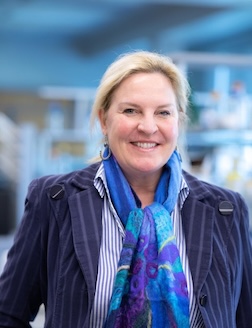Tale of Two Cities: Disease-Based Research or Geroscience?
to

Laura Niedernhofer, M.D., Ph.D.
Professor
The University of Minnesota, Medical School
Laura Niedernhofer joined the University of Minnesota in July 2018 to direct the new Institute on the Biology of Aging & Metabolism (iBAM) and Medical Discovery Team on the Biology of Aging. She is also a Professor in the Department of Biochemistry, Molecular Biology and Biophysics at UMN. Dr. Niedernhofer’s expertise is in DNA damage and repair, genome instability disorders, cellular senescence and aging. Her research program is centered on studying fundamental mechanisms of aging and developing therapeutics to target them. Her research program implements a murine model of a human progeroid syndrome caused by a defect in DNA repair. She contributed to the discovery of a new class of drugs called senolytics. Laura has served on study section for NCI, NIEHS and NIA. She has been awarded for research in aging, cancer and environmental health science.
Summary
https://videocast.nih.gov/watch=52615
The socioeconomic challenges raised by our rapidly aging world population demands attention from global leaders and legislators at all levels of government. Solutions will only come from innovative new biomedical and technological approaches to healthcare. Aging biology is extremely complex: molecular, organelle, cellular, paracrine, endocrine, organ, and systems biology changes all occur virtually universally in nematodes to mammals. However, discerning cause from effect in aging biology (analogy: hypertension causes heart disease) has been a challenge for decades, making traditional approaches to tackling prominent health care problems ineffective in aging (analogy: there are molecular targets unique to tumors). Several facts about aging biology launched the innovative Geroscience Hypothesis championed by the Division of Aging Biology at NIA. This hypothesis posits that therapeutically targeting fundamental aging biology will have more impact on the health and health care costs of our aging population than curing any single age-related chronic disease such as cancer, Alzheimer’s, or diabetes. Geroscientists defined potential therapeutic targets of aging biology over a decade ago, defined as the “Hallmarks of Aging”. More recently, the hallmarks were clustered in terms of cause and effect, and innovative clinical trials testing the Geroscience Hypothesis were initiated. The goal of this lectureship is to provide a historical perspective of the incredible progress in Geroscience over the last two decades, my research programs contribution to this field, and a personal perspective on what lies ahead.
Presentation objectives:
- Provide a definition, rationale for, historical perspective of, and current status of Geroscience.
- Define cellular senescence as a hallmark of aging, a geroscience target, and a focus of clinical trials: what we know and what we don’t.
- Illustrate the opportunities and challenges in Geroscience to foster multidisciplinary approaches.
This page was last updated on Thursday, February 15, 2024